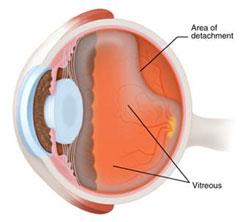
PATIENT RESOURCES
ABOUT BLEPHARTIS

Blepharitis means inflammation of the eyelids that can be caused by bacteria, viruses or be associated with a number of skin conditions such as rosacea and atopic dermatitis.
Symptoms of blepharitis include irritation and tenderness of the eyelid margins. Signs of blepharitis include redness, swelling and flaking of the skin around the lid margins. Blepharitis can be a limited flare-up or can be a chronic condition.
Your eye doctor will examine you to determine if you have blepharitis and if so, determine what type of blepharitis you have. He or she will then discuss the various treatment options that are available. These include over the counter remedies as well as prescription eyedrops and ointments.

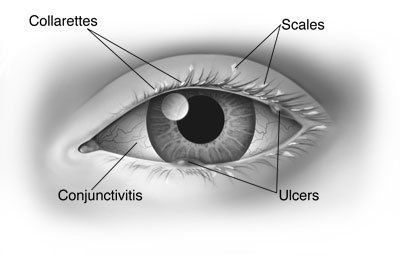
ABOUT CATARACTS

A cataract develops as the crystalline lens inside the eye loses transparency. This results in a decreasing ability to see fine details and ultimately complete loss of vision if the cataract is left to progress. Cataracts are caused by both genetic and environmental factors. Cataracts cause loss of visual clarity, “ghost” images, doubling of vision and glare. Risk factors for developing cataracts include age, diabetes, exposure to ultraviolet light, smoking and certain medications. Most people develop cataracts at some point in life and at least half will require cataract surgery.
During surgery, the cloudy crystalline lens (cataract) is broken up and vacuumed out of the eye. Immediately afterwards an artificial lens implant is placed in the same position. These lens implants, like glasses, have a prescription in them that is chosen based on the shape of the patient’s eye. The beauty of this is that cataract surgery can result in the ability to see well without glasses or contact lenses. The advances in the design of lens implants over the past several years have been impressive. We now have superb lens implants that correct near-sightedness, far-sightedness and astigmatism. We have multifocal lens implants that allow one to both see far to drive and read without glasses. These lens implants have a very high rate of patient satisfaction and about 1/3rd of our patients opt for this.
Cataract surgery is performed on an outpatient basis under local anesthesia with sedation. We are fortunate to have a state-of-the-art facility right here in our building!
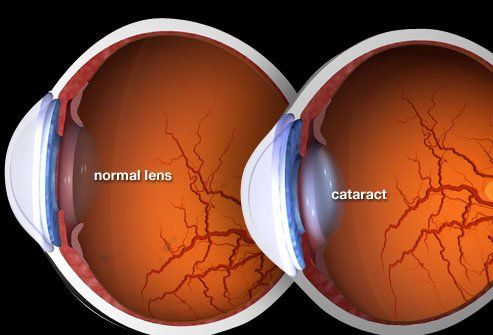
ABOUT CONJUNCTIVITIS

Conjunctivitis is an inflammation of the lining that covers the white part of the eye. It can be caused by either bacterial or viral infections which is known as “pink eye”.
This condition can be highly contagious! Typically someone has had a cold or has been around someone who has had a cold or other infectious illness. It can affect one or both eyes. It commonly starts in one eye and then spreads to the other eye. One may wake up in the morning finding that their eyelids are glued shut. A watery or mucous discharge is common. Conjunctivits can also be caused by allergies to things in the environment or even to contact lenses. The white part of the eye becomes red and the eyelids can become red and swollen also.
Treatment depends upon the cause of the condition. A careful eye exam will help determine the likely cause. Treatment may include antibiotic drops, allergy drops and sometimes steroid drops for a short time.
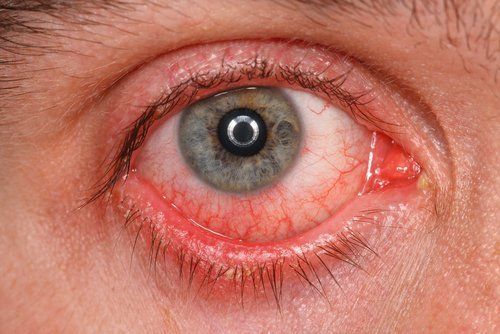
ABOUT DIABETIC RETINOPATHY

Diabetic retinopathy occurs as a result of diabetes causing the closure of small blood vessels in the retina and weakening blood vessels within the retina. The damage causes bleeding within the retina, leakage of fluid within the retina which causes swelling and bleeding within the vitreous cavity of the eye. These changes can diminish eyesight and lead to permanent damage and blindness in worst cases. Diabetic retinopathy is the leading cause of blindness in adults in the United States. Because visual symptoms are rare in the early stages of diabetic retinopathy it is critical that diabetics undergo regular dilated eye examinations. The risk for diabetic retinopathy increases with poorly controlled diabetes, high blood pressure, and smoking.
At a minimum, annual eye exams are strongly recommended for all diabetic patients. Control of blood sugar level is key to minimizing the risk of diabetic retinopathy. Treatments for diabetic retinopathy, include laser eye surgery and intraocular injection of medications to shrink abnormal blood vessels can be very successful. Early diagnosis is very important.

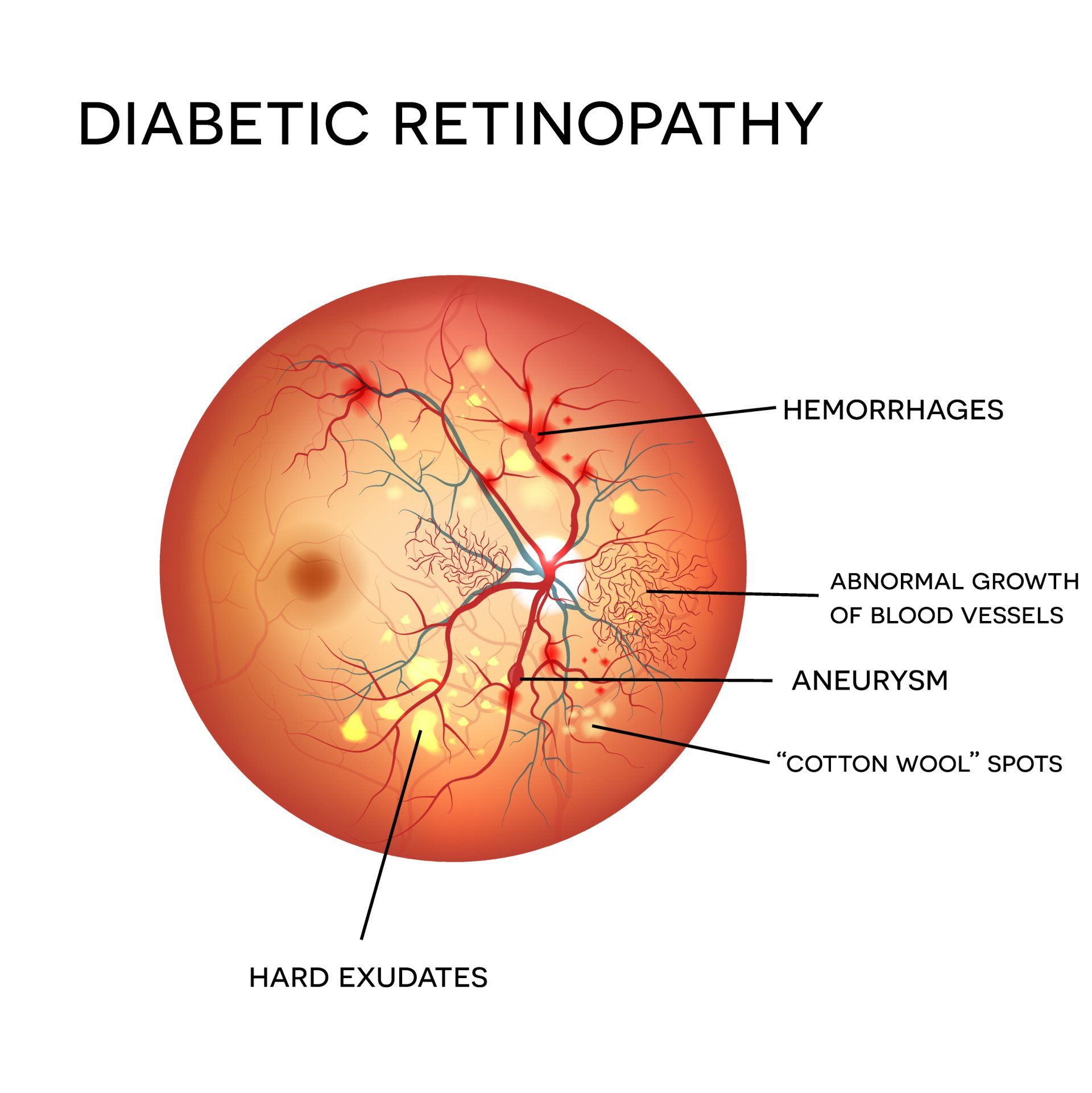
ABOUT DRY EYE SYNDROME

The Santa Clarita and Antelope Valleys are plenty hot and dry! The lack of humidity causes many to suffer from dry eye syndrome, even unknowingly.
The symptoms of dry eye syndrome commonly include the fluctuating vision, chronic redness, a sandy or gritty sensation, excess mucous discharge and surprisingly, excess tearing. Many sufferers note that their vision gets blurry and improves with blinking. It is also common to note blurry vision when working on the computer for a long stretch of time.
It is helpful to have a basic understanding of what tears are made of. The watery component to tears is mainly produced by the lacrimal gland which is located on the upper outer area of the eye socket. These glands are affected by inflammatory conditions such as Sjogren’s syndrome which causes these glands to produce less fluid. There is a mucous component to tears which is produced by “Goblet” cells which are scattered through the conjunctiva over the white part of the eye.
The third main component is an oil produced by Meibomian glands located across the upper and lower eyelids and which empty out across the eyelid margin. A deficit in any of these three main components can lead to dry eye symptoms.
There are a variety of dry eye treatments that are aimed at a particular component of the tear film. Sometimes increasing one component is enough to offset a deficit in a different component and sometimes only improving the particular deficiency will provide relief. Every person is different and what works for one will not necessarily work for another. The idea is to provide the most relief with the least amount of effort and expense.
If the occasional use of a lubricant drop is not giving you enough relief, a thorough evaluation is needed to see if you have dry eye syndrome and customize a treatment for you. At Helm Vision Group we have treatment options that are uniquely available and very effective such as IPL treatment for dry eye syndrome.
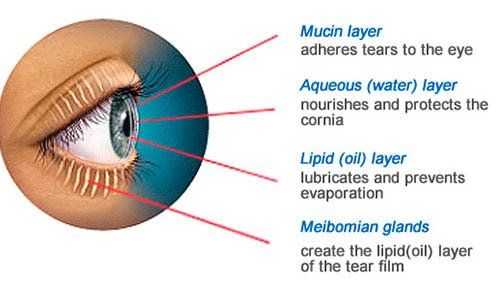
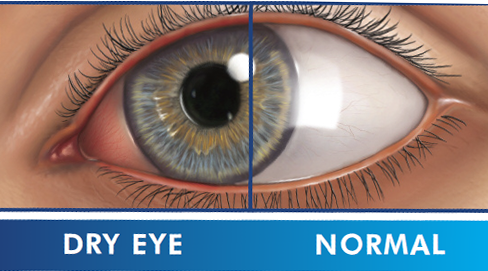
ABOUT GLAUCOMA

Glaucoma is an eye disease in which the optic nerve becomes damaged leading to loss of vision and in some cases blindness. It is usually associated with elevated pressure inside the eye but can occur even with normal intraocular pressure.
Research has found that some people’s optic nerves are more susceptible to damage. When this occurs, the optic nerve tissue slowly dies and vision is lost permanently.
Open angle glaucoma, the most common form, has no symptoms until a substantial amount of peripheral vision is lost. Risk factors for glaucoma include age over 40, family history of glaucoma, diabetes, high blood pressure and African ancestry.
An eye exam includes a measurement of the pressure of the eye as well as an evaluation of the optic nerve. If there are any suspicious findings found during this exam, special tests are ordered to look for evidence of glaucoma. Treatments for glaucoma include prescription eyedrops that lower the pressure of the eye. Laser treatment and other surgical treatments are used if the eye drops are not effective enough.

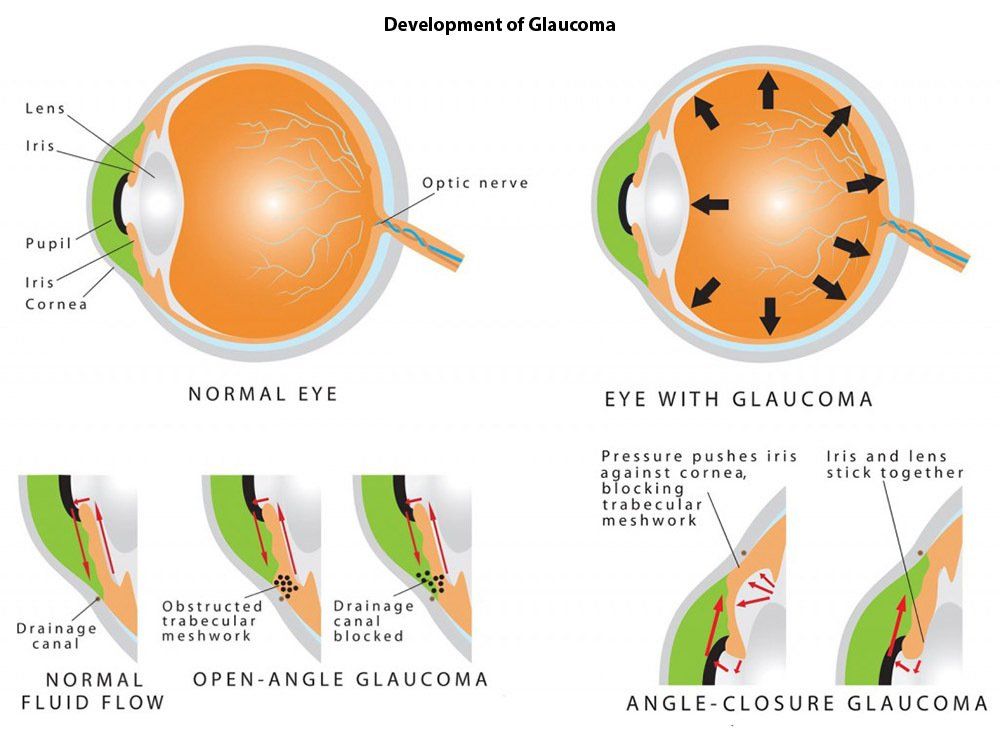
ABOUT MACULAR GENERATION

Macular degeneration is an age-related degenerative eye disease which causes loss of central vision. The macula is the center portion of the retina. When this macula area becomes compromised central vision becomes distorted. There are two types of macular degeneration: dry and wet. A dilated eye examination can determine if there is evidence of macular degeneration. High resolution images of the retina are used if needed to see early evidence of macular degeneration. Significant risk factors for macular degeneration include smoking and family history of macular degeneration.
Having an annual dilated eye exam is important for to allow the us to examine the macula carefully. Research has shown that certain vitamins and proper sunglass protection for ultraviolet sunlight exposure may be helpful to lessen the risk of macular degeneration. There are exciting new treatments for macular degeneration that have kept many patients from losing their vision! Early diagnosis and regular examinations are crucial to protecting eyesight in macular degeneration patients.
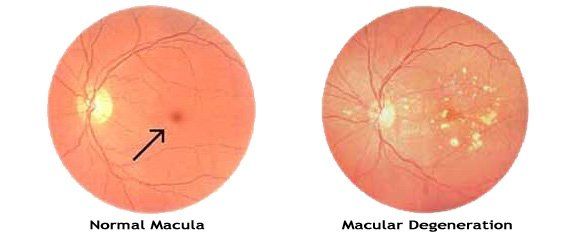
ABOUT RETINAL TEARS AND DETACHMENTS

Retinal tears and detachments are conditions where the inner lining of the eye called the retina is torn leading to separation from the inner wall of the eye. A retinal tear describes a break in the retina, whereas a retinal detachment describes a separation of the retina from it’s normal position. Symptoms include, sudden onset of flashing lights and/or floaters or having a shade cover part of the peripheral vision.
Prompt evaluation is important should these symptoms occur! Please contact us immediately should you experience these symptoms. A dilated eye exam is very important to determine if a retina tear or detachment has occurred. Permanent eyesight loss may occur if the retina problem is not treated in a timely manner. Various new methods of retinal surgery are used successfully to preserve eyesight when the condition is treated promptly!
